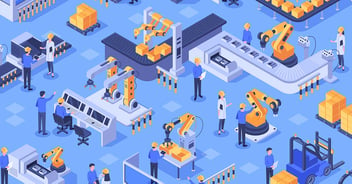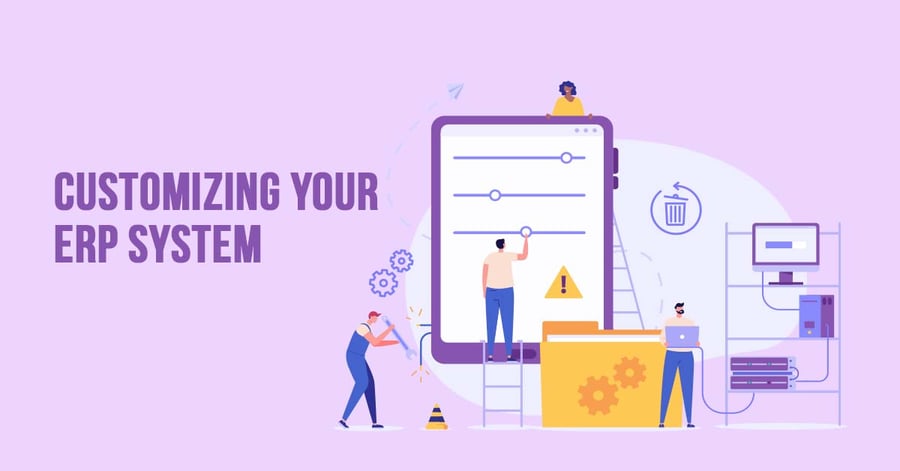
ERP System Customization Challenges and How Businesses Can Overcome Them
ERP System Customization Challenges & How to Overcome Them
7:46
Published :

International operations, remote and on-the-go working as well as digital transformation of businesses are some of the key realities for any of the contemporary businesses. Companies are leveraging tech solutions such as the ERP system to streamline their operations, improve customer experience and efficiencies. However, when a business decides to implement a world-class enterprise asset management system for its operations, it faces challenges in customizing it to the specific business needs. After all, the vendors make such software for mass market, and may not offer out-of-the-box suitability for each user.
If you are looking for an advanced ERP system for your business then you must know about these customization challenges and also about ways to overcome them:
Before deploying an enterprise asset management solution, you need to be clear about what objective it is aimed at serving. It could be improving productivity, streamlining workflows, cutting costs and so on. The customization process will be successful only if the specific goals are achieved.
Over 40% of the companies end up overspending on ERP system implementation than the budget initially allocated. For large global companies, this could be additional cost of hundreds of thousands of dollars. This additional cost could have a much worse impact on mid-sized companies that work on a lower revenue base and thin margins.
Typically, a vendor will offer dedicated support for the standard software, and provide users with updates and patches. You will get support in implementation and initial testing etc. However, when companies customize the software to add bespoke features and integrations, they need to spend on maintenance of such customizations at their end. At times, the IT teams might get confused whether a glitch is to be handled at the vendor’s end or the company’s end. As a result, it could affect operations and even cause cybersecurity risks.
New technologies such as advanced cloud ERP system might be something that your employees are not used to. They may struggle with it or even avoid using it and continue with the old practices that they had mastered. This change resistance often proves to undermine the software deployment.
To begin with, the company needs to first set clear goals. Brainstorming between leaders and workforce has to be done on whether and what kind of ERP solutions will bring about the desired efficiencies to the business. Ideally a cloud-based enterprise asset management system will be able to offer all kinds of customizations and integrations to suit the business. It would be able to serve demands of organizations in every sector and scale. Still, there can also be times when the business doesn’t even need ERP services. Therefore, set clear goals before you start looking for a software.
Too many customizations can cause confusions. Vendor’s customer support team might not be able to provide timely resolution of such ERP software customizations, and overcoming malfunctions, cybersecurity challenges and updating the ERP software could be major hurdles. Therefore, it is important to clearly define and limit the customizations to the minimum and only as per the core needs of the business.
You would know the vendor quote upfront, but you must also take time to calculate precisely how much is likely to be spent on the ERP system customizations, and not only the initial costs, but costs of maintenance and subsequent updates should also be calculated.
Customizing the ERP system doesn’t necessarily imply that you hire developers and designers to create additional features. A world-class SaaS vendor would know that each client project is unique, and will offer customization as a part of the product deal. You need to find a provider with adequate experience and understanding of global operations as well as cutting-edge technologies. Going for an ERP system based in cloud, and offered by a vendor ready to provide managed services support would be highly recommended. It is better to select a partner that is able to manage the system throughout – from implementation, to service and support. It ensures that the customizations are managed centrally.
As businesses evolve, the need for scalable erp solutions becomes increasingly critical. Customization only addresses current requirements, but long-term value comes from ensuring that the ERP architecture supports future expansion. This includes accommodating increased transaction volumes, multi-location operations, and seamless integration with emerging tools such as AI-driven analytics and IoT-based monitoring systems. Scalable erp solutions provide businesses with flexibility and minimize disruption during growth phases.
One of the most powerful advantages of modern erp services is the ability to centralize data and convert it into actionable insights. With real-time dashboards and advanced reporting, businesses can identify inefficiencies, predict maintenance needs, and enhance allocation of resources. Leveraging machine learning capabilities within erp services enables proactive decision-making rather than reactive problem-solving. This approach significantly boosts operational efficiency and aligns internal processes with strategic objectives.
In a world of increasing cyber threats and evolving regulatory norms, selecting erp services with built-in compliance and cybersecurity protocols is vital. Advanced erp solutions now come equipped with monitoring, encryption, and access control capabilities that safeguard critical business data. Businesses must collaborate with vendors who can continuously update security features across all customized modules. This ensures compliance with regional regulations and reduces exposure to operational risks.
The journey doesn’t end after deployment. Companies should establish a continuous improvement model wherein erp solutions are evaluated against KPIs and updated regularly. Ongoing training, feedback loops, and performance audits ensure that the system evolves with business needs. Expert-led erp services provide structured optimization plans that help organizations maximize ROI over time, ensuring that the ERP remains a growth enabler rather than a static tool.
By adopting forward-thinking strategies and dependable erp services, businesses can unlock the full potential of their custom ERP platforms and thrive in competitive markets.
ERP software customizations are a necessity, but if carried out without due planning, they can cause headaches for the business. Market leading service providers offer cloud-based ERP Software solutions that offer customizations and seamless integrations with leading third-party software as well. Therefore, if you are going for an ERP system deployment, make sure it is not a legacy tool, but a cutting-edge ERP system that will serve the business effectively in the years to come!
ERP implementations frequently exceed budget due to unforeseen customization requirements, underestimated maintenance costs, and integration complexities. Large organizations may face substantial additional expenses, while mid-sized businesses with limited margins are even more vulnerable. Accurate cost estimation, clear goal setting, and a phased approach to customization are critical to prevent overspending and ensure ROI.
The right level of ERP customization should focus on core business needs without overcomplicating the system. Companies must evaluate which workflows require automation, prioritize critical integrations, and avoid unnecessary features that increase costs or maintenance burdens. Minimal, targeted customization ensures smooth vendor support, reduces cybersecurity risks, and improves employee adoption for long-term efficiency.
Choosing the right ERP vendor involves evaluating their global experience, industry knowledge, and ability to provide cloud-based solutions with managed services. Vendors should offer scalable platforms, continuous support, and seamless integration capabilities. Prioritizing a partner who manages implementation, updates, and customizations centrally ensures businesses can maintain operational efficiency while minimizing disruptions and IT overhead.
Modern ERP platforms are designed for scalability, accommodating multi-location operations, increasing transaction volumes, and integrating emerging technologies such as AI and IoT. Cloud-based ERPs allow businesses to expand without disruption, optimize resources, and maintain operational continuity. Scalable systems ensure organizations can meet future demands while keeping processes efficient, compliant, and aligned with strategic growth objectives.
ERP solutions centralize operational, financial, and inventory data, converting it into actionable insights via dashboards and reports. Machine learning and predictive analytics help businesses identify inefficiencies, forecast demand, and optimize resource allocation. By enabling proactive decision-making, ERP improves operational efficiency, reduces costs, and ensures strategic alignment across departments for smarter business growth.
Cybersecurity and compliance are critical when customizing ERP systems. Advanced ERPs include built-in encryption, access control, and monitoring features to protect sensitive business data. Vendors regularly update modules to meet evolving regional regulations, minimizing operational risk. Proper management ensures secure operations, regulatory adherence, and protects the organization from potential cyber threats and legal liabilities.
Employee adoption is essential for ERP success. Organizations should invest in training, change management, and continuous support to help staff transition smoothly. Demonstrating clear benefits, streamlining workflows, and encouraging feedback enhances engagement. When employees understand how ERP simplifies daily tasks and improves performance, adoption rates increase, maximizing the value of ERP investments.

All Rights Reserved. © Copyright 2024. Ramco Systems.